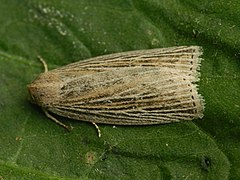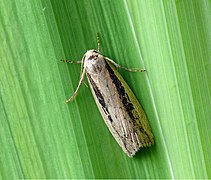Narrow-winged reed owl
| Narrow-winged reed owl | ||||||||||||
|---|---|---|---|---|---|---|---|---|---|---|---|---|

Narrow-winged reed owl ( Chilodes maritima ), |
||||||||||||
| Systematics | ||||||||||||
|
||||||||||||
| Scientific name | ||||||||||||
| Chilodes maritima | ||||||||||||
| ( Tauscher , 1806) |
The narrow-winged reed owl ( Chilodes maritima ), sometimes also called water-reed reed owl , is a butterfly ( moth ) from the owl butterfly family (Noctuidae). The specific epithet is derived from the Latin word maritimus , meaning “belonging to the sea”, because the species also occurs on the seashore.
features
butterfly
With a wingspan of 28 to 35 millimeters, the moths are among the smaller owl butterflies. The narrow fore wings, which taper off at the apex, are striking . They are extremely variable in color. There are almost no-drawing ocher-colored to pale reddish-brown shapes, as well as monochrome dark brown ones, those with round, black-brown kidney and ring flaws of the same size, as well as specimens with a wide black central stripe that covers the flaws and runs from the root to the hem. Another shape shows a dark pattern between the veins. The outer transverse line is broken up into black dots. There are also a number of small black dots running along the edge. The upper side of the hind wing is colored whitish, whereby the veins and a crescent-shaped discoidal spot stand out darker.
Caterpillar
The caterpillars are yellowish to ocher in color, have a slender, elongated shape and taper in the front. The lines of the back and the side of the back stand out faintly and are sometimes interrupted. The stigmas are black, the head is reddish brown.
Similar species
There is a certain similarity to the welted reed owl ( Senta flammea ), which also has narrow forewings and a generally ocher tint. However, the dark median is wider in this species and does not reach the hem, and it always lacks the blemishes.
distribution and habitat
The distribution of the narrow-winged reed owl extends through the middle of Europe to Siberia . It is also found in Asia Minor as well as in West and Central Asia. The main habitat is coastal areas, reed-covered banks of rivers, ponds and lakes, as well as wet meadows, swamps and moors.
Way of life
In northern regions the species shows a univoltine behavior and the moths fly from June to August. If copies are still found in September, they should belong to a partial second generation. They are predominantly nocturnal and appear in artificial light sources . The caterpillars live from September, overwinter and pupate in reed stubble in May of the following year. The main forage plant of the caterpillars before wintering is the reed ( Phragmites australis Syn . : Phragmites communis ). They spend their development time inside the reed stalks, where they eat the pulp. In the spring, various insect larvae living in the reeds are sometimes destroyed. Under breeding conditions, the caterpillars even accept scraped, raw meat as food.
Danger
The species occurs in different numbers in Germany. Because of the caterpillar food it is tied to reed stocks and is classified in category 3 ("endangered") on the Red List of Endangered Species . Due to the reduction of the reed populations through cultivation and lowering of the groundwater, a threatening stock situation has arisen in some areas. The narrow-winged reed owl is therefore "on the forewarning list" in Baden-Württemberg .
Individual evidence
- ^ A b Arno Bergmann: The large butterflies of Central Germany. Volume 4/2: Owls. Distribution, forms and communities. Urania-Verlag, Jena 1954, pp. 809/810
- ^ Arnold Spuler: The butterflies of Europe . tape 1 . E. Schweitzerbartsche Verlagbuchhandlung, Stuttgart 1908, p. 218 .
- ↑ a b Michael Fibiger and Hermann Hacker: Noctuidae Europaeae Volume 9 Amphipyrinae, Condicinae, Eriopinae, Xyleninae (part). , Entomological Press, Sorø 2007 ISBN 87-89430-11-5 , pp. 129/130
- ↑ Markku Savela: distribution. In: Lepidoptera and some other life forms. Retrieved January 15, 2020 .
- ↑ Manfred Koch: We identify butterflies. Volume 3: Owls. 2nd, expanded edition. , Neumann Verlag, Leipzig / Radebeul, 1972, pp. 214/215
- ↑ Walter Forster, Theodor A. Wohlfahrt: The butterflies of Central Europe. Volume 4: Owls. (Noctuidae). Franckh'sche Verlagshandlung, Stuttgart 1971, ISBN 3-440-03752-5 , pp. 164/165
- ↑ a b Günter Ebert (Ed.): The butterflies of Baden-Württemberg. 1st edition. Volume 6. Moths IV. Noctuidae 2nd part. Ulmer, Stuttgart (Hohenheim) 1997, ISBN 3-8001-3482-9 , pp. 319-322
- ^ Günter Ebert (Ed.): The butterflies of Baden-Württemberg. 1st edition. Volume 10: Supplementary volume Ulmer, Stuttgart (Hohenheim) 2005, ISBN 3-8001-4383-6 , p. 32
- ^ Karl Eckstein: The butterflies of Germany with special consideration of their biology, Volume 3, Die eulenhaben Falter , KG Lutz 'Verlag 1920, p. 48
- ↑ Federal Agency for Nature Conservation (Ed.): Red List of Endangered Animals in Germany. , Landwirtschaftsverlag, Münster, 1998, ISBN 3-89624-110-9
literature
- Michael Fibiger and Hermann Hacker: Noctuidae Europaeae Volume 9 Amphipyrinae, Condicinae, Eriopinae, Xyleninae (part). , Entomological Press, Sorø 2007 ISBN 87-89430-11-5
- Günter Ebert (Ed.): The butterflies of Baden-Württemberg. 1st edition. Volume 6. Moths IV. Noctuidae 2nd part. Ulmer, Stuttgart (Hohenheim) 1997, ISBN 3-8001-3482-9
- Walter Forster, Theodor A. Wohlfahrt: The butterflies of Central Europe. Volume 4: Owls. (Noctuidae). Franckh'sche Verlagshandlung, Stuttgart 1971, ISBN 3-440-03752-5
Web links
- Lepiforum eV - taxonomy and photos
- www.schmetterlinge-deutschlands.de - endangerment
- ukmoths - UKMoths
- leps.it - Moths and Butterflies of Europe and North Africa




